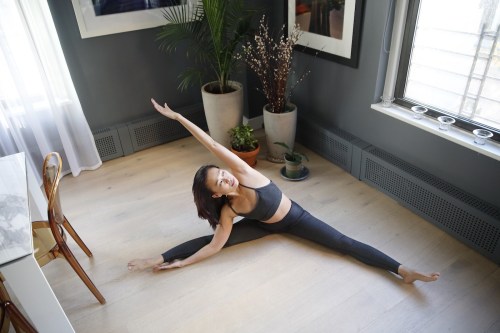Why you shouldn’t hold a stretch for longer than 3 seconds
Wondering how to avoid overstretching? Meet "active stretching," the 3-second tweak that will ensure your muscles stay limber (but not *too* limber).

There’s a reason why everyone from Simone Biles to your local spin instructor swears by stretching as an important part of any fitness routine: Not only does it help soothe sore muscles, but it also helps get them prepped and ready to function in fighting force during your next workout. Chances are, you’re familiar with the usual roster of moves that seem to appear at the beginning and end of every workout class. But Well+Good recently did a deep dive into the world of stretching, and discovered a principle of flexibility worth putting on our radars.
For a new episode of What the Wellness, our brave video producer Ella Dove got professionally stretched (yup—that’s a thing) at NYC’s Stretch*d studio. In the video, she described the experience as “the best thing of her life” and like a “stretchy roller coaster”—both of which sound a-m-a-z-i-n-g if you ask me. But during her time at Stretch*d, she also learned an important lesson that the rest of us can steal as a part of our own stretching routines.
You see, Stretch*d sessions are based on the principles of “active flexibility,” which means that you’re moving in and out of stretches so that you’re never in any particular position for longer than three seconds. This, apparently, helps you avoid over-stretching, so you’re less apt to pull anything or hurt yourself. “The whole idea behind the is that it’s movement-based, so it’s never pushing past the point of flexibility,” explains Vanessa Chu, co-founder of Stretch*d.
Jeff Brannigan, Stretch*d’s director of programming tells me that active flexibility helps to improve the range of motion in joints and muscles through controlled, active repetitions. “This is different from passive or static stretching because it requires movement and stretches are not held for long periods of time,” he says. “This helps avoid over-stretching, which is actually possible to do when placing too much weight or strain on the muscle and joint or pushing a stretch too far, too quickly.”
The Stretch*d technique involves holding individual stretches for two to three seconds each, then repeating up to 10 times in one step. “The repetitive motion uses something called reciprocal inhibition, which requires a contraction of one muscle group so the opposite—and the targeted muscles for the stretch—can relax,” says Brannigan. For example, if you want to stretch your hamstring, you should engage your opposite muscle group, which is the quadricep, so that the hamstring can relax. “The repetitions help build circulation, which is why this type of stretching can be done both before and after a workout. Post-workout, it helps flush out metabolic waste therefore speeding up recovery.”
Watch the video below to see active stretching in action (and to see Ella try on some wild-looking space pants for the sake of her muscle recovery), and be sure to add it to your own post-sweat sesh routine.
In addition to active stretching, there are a few other things you can do to avoid overdoing it on your muscles. And try this quick stretching routine that will actually help you become more flexible.
Sign Up for Our Daily Newsletter
Get all the latest in wellness, trends, food, fitness, beauty, and more delivered right to your inbox.
Got it, you've been added to our email list.










